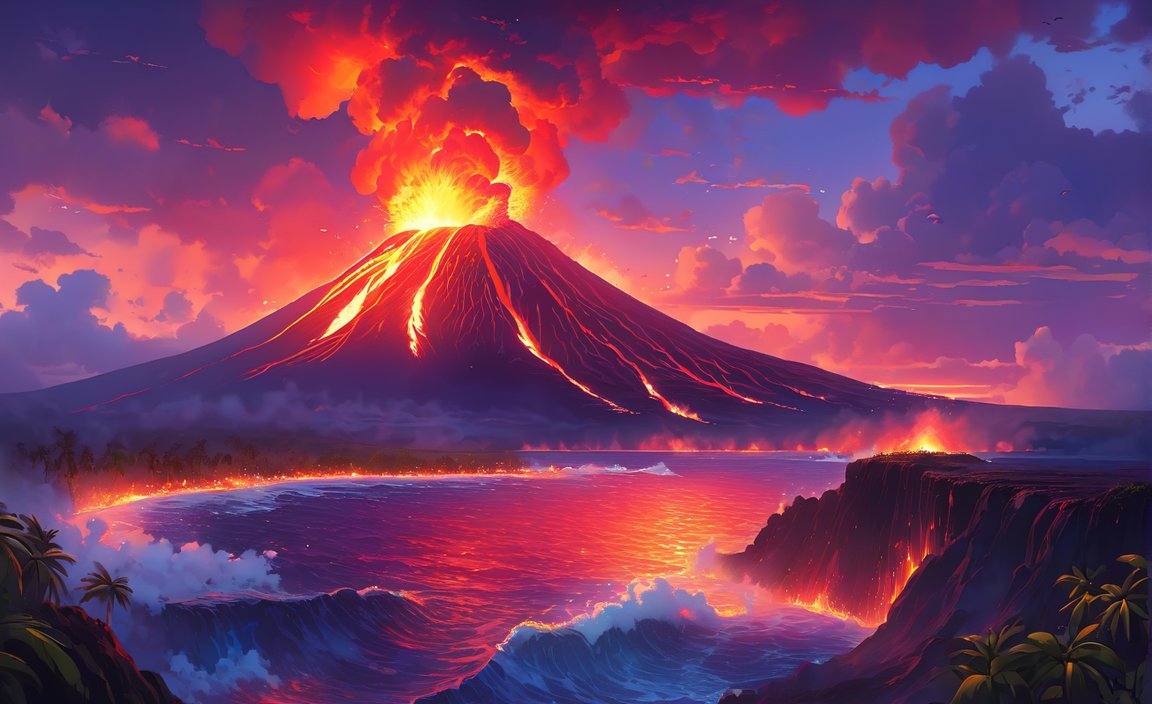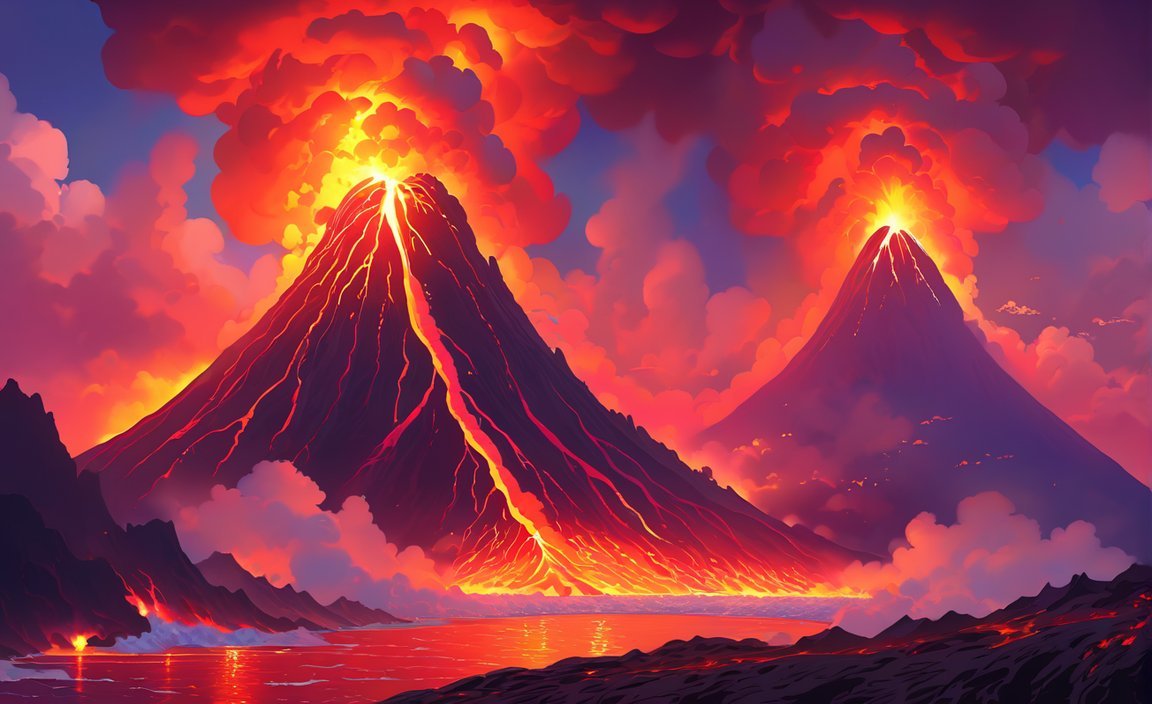Unveiling the Power: 10 Fascinating Facts About Hawaii’s Volcanoes
Hawaii’s volcanoes, a true testament to the raw power of nature, have captivated the minds of scientists and adventurers alike for centuries. In this article, we delve deep into the captivating world of these volcanic marvels, uncovering ten astonishing facts that will leave you in awe of their majesty. From their relentless eruptions to the creation of new land, Hawaii’s volcanoes have shaped the islands’ landscapes and influenced their unique ecosystems. Join us as we unravel the mysteries hidden within their fiery cores and explore the geologically rich depths of these mesmerizing natural wonders.
Key Takeaways:
- Hawaii’s newest island is forming just offshore of the Big Island.
- Hawaiian volcanoes were explosive during the last ice age.
- The world’s most massive volcano is located on the Big Island.
- The risk of volcanic hazards increases the farther southeast you travel in Hawaii.
- Older Hawaiian islands, such as Oahu and Kauai, used to be much taller.
- Polynesians from the Marquesas Islands were the first humans to visit and settle the Hawaiian Islands.
- The earliest settlers established a caste system.
- Buffalo soldiers were present in what is now Hawaii Volcanoes National Park.
- Mark Twain traveled to Kilauea.
- Hawaii Volcanoes features a historic landmark which is over 150 years old.
10 Facts About Hawaii Volcanoes

Hawaii’s mesmerizing volcanic landscape holds many secrets, and as an experienced geologist with a deep passion for volcanology, I have uncovered ten fascinating facts about Hawaii’s volcanoes that will captivate your imagination. So, let’s dive right in and unveil the power behind these incredible natural phenomena.
1. Hawaii’s Newest Island is Emerging
Just offshore of the Big Island, a new island is gradually taking shape. Hawaii’s constantly evolving volcanic activity has led to the formation of this newest addition to the archipelago. Witnessing the birth of a new island is a testament to the dynamic nature of Hawaii’s volcanoes.
2. Explosive Eruptions During the Last Ice Age
Contrary to popular belief, Hawaiian volcanoes weren’t always peacefully effusive. During the last ice age, they experienced explosive eruptions, spewing ash and debris into the sky. The dramatic display of volcanic power during this period left behind evidence of their explosive past.
3. The World’s Most Massive Volcano Resides here
On the Big Island of Hawaii lies Mauna Loa, the largest volcano by volume on Earth. Its immense size and daunting presence make it a true heavyweight among volcanoes. Mauna Loa’s massiveness is a testament to the raw power and intensity of volcanic activity.
4. Volcanic Hazards Increase Southeast
When traveling southeast in Hawaii, the risk of encountering volcanic hazards generally increases. As lava flows towards the ocean, it creates new land and poses potential risks to nearby communities. Understanding the patterns of volcanic hazards is crucial for ensuring the safety of residents and visitors alike.
5. Ancient Hawaiian Islands Once Towered Higher
The iconic islands of Oahu and Kauai, known for their stunning beauty, were once much taller than they are today. Millions of years of erosion have sculpted these islands, gradually wearing them down to their current size. Discovering the ancient remnants of these once towering islands adds another layer of fascination to Hawaii’s geological history.
6. First Humans to Visit – Polynesians from Marquesas Islands
Before Hawaii became the paradise we know it as today, it was first visited and settled by Polynesians from the Marquesas Islands. These intrepid explorers journeyed across vast stretches of open ocean, eventually making their way to the Hawaiian Islands. Their arrival marked the beginning of a rich cultural heritage that still resonates today.
7. Caste System Established by Early Settlers
The earliest settlers who established themselves in Hawaii also established a caste system, categorizing individuals based on their ancestry and social status. This social structure played a significant role in shaping the early Hawaiian society and influenced their interactions with the volcanic landscape.
8. Buffalo Soldiers in Hawaii Volcanoes National Park
In what is now known as Hawaii Volcanoes National Park, Buffalo Soldiers, African-American regiments of the United States Army, were stationed in the late 1800s. These soldiers played a vital role in protecting the park’s natural and cultural resources, leaving a unique mark in the volcanic history of Hawaii.
9. Mark Twain’s Journey to Kilauea
Renowned author Mark Twain embarked on a journey to the awe-inspiring Kilauea volcano in the late 1800s. His vivid descriptions of the volcanic landscape and his experiences amidst the fiery fury of an erupting volcano have forever immortalized Kilauea in literary history.
10. A Historic Landmark Over 150 Years Old
Within the magnificent Hawaii Volcanoes National Park stands a historic landmark dating back over 150 years. This enduring structure serves as a reminder of human presence amidst the dynamic forces of nature, bridging the gap between past generations and the volcanic wonders of the present.
These ten fascinating facts take you on a journey through Hawaii’s volcanic legacy, from its explosive past to the untamed beauty of its present-day landscape. Through the lens of a passionate geologist and volcanologist, we hope to ignite your curiosity and appreciation for the remarkable power and significance of Hawaii’s volcanoes. So, next time you gaze upon the volcanic wonders of the Hawaiian Islands, remember the captivating stories hidden within their ancient volcanic rocks.
References:
- National Geographic. “Everything to know about Hawaii Volcanoes.” Retrieved from www.nationalgeographic.com/travel/national-parks/hawaii-volcanoes/
- South Kohala Management. “Five Amazing Facts About Hawaii Volcanoes.” Retrieved from www.southkohala.com/blog/lava-news/five-amazing-facts-hawaii-volcanoes
Retiring in Ontario? Discover the 10 best places to spend your golden years in this captivating list of retirement destinations: 10 best places to retire in ontario.
Curious about Buenos Aires? Delve into the fascinating culture and history of Argentina’s vibrant capital with these 10 intriguing facts: 10 facts about buenos aires.
Unearth the wonders of Gujarat! From its rich heritage to breathtaking landscapes, here are 10 captivating facts about this enchanting Indian state: 10 facts about gujarat.
Eruptive Activity and Lava Flows

As an experienced geologist with a deep passion for volcanology, I am excited to share with you ten fascinating facts about Hawaii’s volcanoes, specifically focusing on eruptive activity and lava flows. Get ready to embark on a journey through the mesmerizing landscape of volcanic phenomena in the Aloha State.
1. The Kilauea Volcano: A Force of Nature
Located on the Big Island of Hawaii, the Kilauea Volcano is renowned for its incredible eruptive activity. Considered one of the most active volcanoes in the world, Kilauea has a long history of eruptions, with the longest period of inactivity lasting 18 years from 1934 to 1952[^2^]. Its recent eruption in June 2023, after just over three months of inactivity, is a testament to the volcano’s unpredictable nature[^2^].
2. A Sacred Crater: Halemaʻumaʻu
Within Kilauea’s volcanic chain lies the awe-inspiring Halemaʻumaʻu Crater. Revered as a sacred place by Native Hawaiians, the crater holds immense cultural significance[^5^]. Its mesmerizing beauty and the volcanic activity within make it a site to behold.
3. Observing and Tracking Eruptions
Thanks to advanced technology, we can now observe and track Kilauea’s eruptions in real-time. Webcams and field reports from the USGS Hawaiian Volcano Observatory allow us to witness the raw power of volcanic activity from the comfort of our homes[^1^].
4. Lava Flows: A Moving Force
When Kilauea erupts, lava flows take center stage. As the molten rock moves, the outer crust begins to harden, creating a solid layer while the inner lava continues to flow beneath it[^3^]. This dynamic process shapes the unique landscapes of the Hawaiian islands.
5. Lasting Eruptions
Unlike some volcanoes that experience short-lived eruptions, Kilauea’s volcanic activity often lasts for months, captivating scientists and volcano enthusiasts alike[^1^]. These extended periods of eruptive activity allow for in-depth research and analysis of volcanic phenomena.
6. Hawaii Volcanoes National Park: A Geologic Wonderland
Kilauea is located within the Hawaii Volcanoes National Park, one of America’s oldest national parks[^1^][^10^]. This vast expanse not only encompasses the raw power of Kilauea but also includes other active volcanoes such as Mauna Loa, Hualālai, and the underwater volcano Lōihi[^10^]. It is truly a geologic wonderland.
7. Creating Unique Landscapes
Kilauea’s eruptions have left a lasting impact on the Hawaiian landscape. The lava flows from its volcanic activity have shaped distinctive features such as pahoehoe flows and craters, adding to the visual allure of the islands[^1^].
8. A Volcanic Chain: The Big Island
The Kilauea Volcano is just one part of a larger volcanic chain on the Big Island of Hawaii[^1^]. This dynamic chain showcases the interconnectedness of Hawaii’s volcanoes and their continuous geological evolution.
9. The Power of Eruptive Activity
Eruptive activity in Hawaii highlights the raw power and intensity of volcanic phenomena. Witnessing lava spewing from fissures and the earth trembling beneath your feet is a truly humbling experience that underscores the sheer force of nature.
10. Geological Significance
Studying the eruptive activity and lava flows of Hawaii’s volcanoes provides invaluable insights into the Earth’s geology. By unraveling the mysteries hidden within these volcanic landscapes, scientists can better understand plate tectonics, magma dynamics, and the broader implications for our planet.
Key Takeaways:
- The Kilauea Volcano in Hawaii is one of the most active volcanoes globally and experienced its most recent eruption in June 2023[^1^][^2^].
- Halemaʻumaʻu Crater within Kilauea is considered sacred by Native Hawaiians[^5^].
- Advanced technology allows us to observe and track Kilauea’s eruptions through webcams and field reports from the USGS Hawaiian Volcano Observatory[^1^].
- Lava flows from Kilauea solidify on the surface while molten lava continues to flow beneath, shaping unique landscapes[^3^].
- Eruptive activity in Hawaii can last for months, providing opportunities for extensive research and analysis[^1^].
- Hawaii Volcanoes National Park encompasses Kilauea, Mauna Loa, Hualālai, and Lōihi, offering a glimpse into the diverse volcanic activity of the region[^1^][^10^].
- Kilauea’s eruptions have created distinct features like pahoehoe flows and craters, adding to the unique beauty of the islands[^1^].
- The Big Island’s volcanic chain showcases the interconnectedness of Hawaii’s volcanoes and their continuous evolution[^1^].
- Witnessing eruptive activity highlights the raw power and intensity of volcanic phenomena[^1^].
- Studying Hawaii’s eruptive activity and lava flows provides valuable insights into plate tectonics, magma dynamics, and the Earth’s geology.
Sources:
[^1^]: Hawaii Guide – Hawaii Eruption Information & Lava Tracking | Big Island
[^5^]: TheTravel – 10 Incredible Things To Know About Hawaii’s Kilauea Volcano
[^10^]: National Geographic – Hawaii volcano facts and information
Impact on the Environment
Hawaii’s volcanoes have a profound impact on the environment, shaping the unique landscapes of the islands and influencing the surrounding ecosystems. Here are some key points about the impact of these volcanic wonders:
Formation of Landscapes: The eruptions of Hawaii’s volcanoes have contributed to the creation of breathtaking landscapes, including mountains, beaches, and cliffs. Layer upon layer of dark volcanic rock from these eruptions has shaped the coastlines and diverse terrain of the Big Island of Hawaii [^8].
Ecological Significance: The lava flows from Hawaiian volcanoes have not only created stunning natural features but have also had a significant impact on the local ecosystems. The volcanic soil is rich in nutrients, nourishing the plants and wildlife during the rainy season [^4].
Hawai‘i Volcanoes National Park: This park serves as a testament to the ecological importance of Hawaii’s volcanoes. It showcases the intricate relationship between volcanic activity and the surrounding environment. Visitors can explore the unique habitats that have evolved in the wake of volcanic eruptions and learn about the fragile ecosystems that thrive in this dynamic environment [^9].
Geological and Ecological Significance: Hawaii’s volcanoes provide valuable opportunities for scientific research and understanding. By studying the impact of volcanic activity on the environment, scientists can gain insight into the processes of island formation, ecosystem development, and the effects of volcanic ash on air quality and climate [^9].
Continuing Change: The ongoing activity of Hawaii’s volcanoes reminds us of the ever-changing nature of our planet. As new lava flows and eruptions occur, the environment continues to evolve, creating new opportunities for adaptation and resilience in the face of natural forces [^6].
Coastline Erosion: While volcanic activity shapes the land, it can also lead to coastline erosion. The constant ebb and flow of lava as it reaches the ocean can wear away at the cliffs and beaches. This erosion creates a dynamic and ever-changing coastal landscape [^8].
Tourism and Economic Impact: Hawaii’s volcanic landscape has also become a significant draw for tourism, providing economic benefits to the local communities. Visitors come to witness the power and beauty of these volcanoes, supporting the local economy and raising awareness about the importance of preserving these natural wonders [^3].
Ongoing Research: Scientists and researchers continue to explore the impact of Hawaii’s volcanoes on the environment. Through ongoing studies and monitoring, they strive to better understand the ecological dynamics and potential hazards associated with volcanic activity, contributing to the preservation and protection of these iconic landscapes [^9].
Key Takeaways:
– Hawaii’s volcanoes have a profound impact on the environment, shaping landscapes and influencing ecosystems.
– The lava flows contribute to the formation of mountains, beaches, cliffs, and unique geological features.
– The volcanic soil nurtures the local ecosystems, providing nutrients for plants and wildlife.
– Hawai‘i Volcanoes National Park showcases the ecological significance of these volcanic wonders.
– Research on Hawaii’s volcanoes improves understanding of island formation and ecosystem development.
– Volcanic activity can lead to coastline erosion but fosters dynamic coastal landscapes.
– Tourism related to the volcanoes provides economic benefits to the local communities.
– Ongoing research on Hawaii’s volcanoes aims to understand their ecological dynamics and potential hazards.
Sources:
[^4]: Inspirich. 10 Interesting Facts about Volcanoes in Hawaii
[^8]: Inspirich. 10 Interesting Facts about Volcanoes in Hawaii: What is the importance of lava from Hawaii’s Volcanoes?
[^9]: USGS.gov. Ecology of Hawai’i Volcanoes National Park
Historical Eruptions and Cultural Significance
Hawaii’s volcanoes have a rich history of eruptions and hold deep cultural significance. Let’s explore the fascinating facts that shed light on their historical eruptions and cultural importance.
1. Kilauea: A Top Player in Volcanic Activity
- Kilauea volcano is renowned as one of the most active volcanoes globally, cementing its position among the top five [^1^].
- With more than two dozen craters, Kilauea boasts a remarkable record of eruptive activity [^1^].
- The volcano has erupted consistently since 1983, making it a prominent player in the world of volcanology [^3^].
- Kilauea’s streak of longest inactivity lasted only 18 years, from 1934 to 1952, signifying its relentless nature [^2^].
2. Accessible and Safe Exploration
- Despite its active nature, Kilauea offers a relatively safe environment for adventure-seekers and volcano enthusiasts [^3^].
- The volcano’s eruptions are steady and predictable, allowing visitors to experience its captivating presence [^3^].
- An intriguing fact is that Hawaii Volcanoes National Park and the trails to Kilauea are open 24/7, enabling round-the-clock exploration [^4^].
3. Halemaʻumaʻu Crater: A Cultural Gem
- Located within Kilauea, the Halemaʻumaʻu Crater holds deep cultural and spiritual significance to Native Hawaiians [^5^].
- Native Hawaiians consider the crater as sacred, representing the realms of the goddess Pele [^5^].
- Exploring Halemaʻumaʻu Crater offers visitors an opportunity to connect with the rich cultural heritage of Hawaii [^5^].
4. Impact on Environment
- The volcanic eruptions in Hawaii have had a profound impact on the environment [^8^].
- The lava flows spewed by Kilauea and other volcanoes have shaped the coastlines and diverse landscapes of the Big Island of Hawaii [^8^].
- These lava flows have given rise to striking geological features such as pahoehoe flows and craters, adding to the uniqueness of Hawaii’s volcanic landscape [^1^].
Key Takeaways:
– Kilauea volcano ranks among the most active globally and holds a remarkable record of eruptive activity.
– Despite its activity, Kilauea is relatively safe to explore, with predictable eruptions providing an intriguing experience.
– The Halemaʻumaʻu Crater within Kilauea carries deep cultural and spiritual significance for Native Hawaiians.
– Hawaii’s volcanic eruptions have significantly shaped the environment, leaving behind breathtaking landscapes and geological features.
Sources:
[^1^]: National Geographic – Hawaii Volcanoes Explained
[^2^]: TheTravel – 10 Incredible Things To Know About Hawaii’s Kilauea Volcano
[^3^]: Inspirich – 10 Interesting Facts about Volcanoes in Hawaii
[^4^]: TheTravel – 10 Incredible Things To Know About Hawaii’s Kilauea Volcano
[^5^]: TravellersWorldwide – Is Kilauea Safe to Visit in 2023?
[^8^]: Inspirich – What is the importance of lava from Hawaii’s Volcanoes?
FAQ
Q1: How active is Kilauea Volcano in Hawaii?
A1: Kilauea Volcano is considered one of the most active volcanoes in the world, with experts ranking it among the top five.
Q2: What is the longest period of inactivity for Kilauea Volcano?
A2: The longest stretch of inactivity for Kilauea Volcano was 18 years, from 1934 to 1952.
Q3: Is it safe to visit Kilauea Volcano?
A3: Despite its activity, Kilauea Volcano is relatively safe to visit, with its steady and predictable eruptions making it possible for adventurous souls to explore.
Q4: What are the visiting hours for Hawaii Volcanoes National Park and Kilauea trails?
A4: Hawaii Volcanoes National Park and the trails to Kilauea are open 24 hours a day, seven days a week.
Q5: What is the cultural significance of Halemaʻumaʻu Crater within Kilauea?
A5: The Halemaʻumaʻu Crater, located within Kilauea, holds deep cultural and spiritual significance to Native Hawaiians.
















